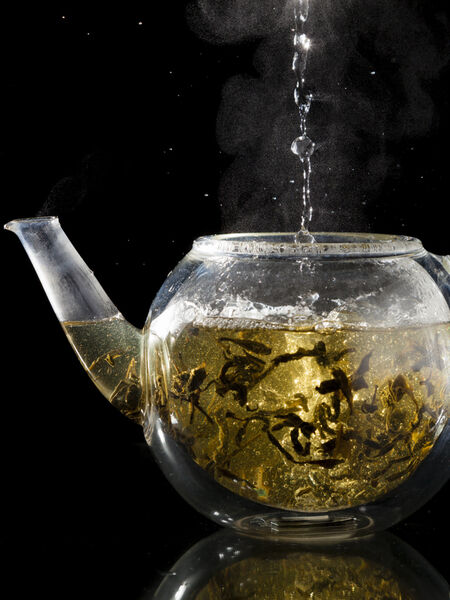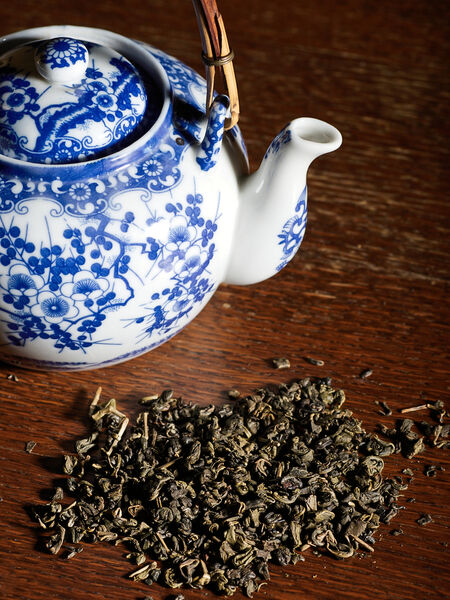Choosing Teapots: Glass, Porcelain, or Ceramic?


One of the auxiliary pleasures of drinking tea is selecting accoutrements: utensils, cups, kettles, storage tins, and, of course, teapots. The choices are legion with a dazzling array of shapes, sizes, decorative touches. Sometimes that blinds us to one of the most important decisions we must make in teapot selection: its function!
Your teapot-buying decision should be based first and foremost on size (options often go from one to six cups, sometimes larger). The next most important aspects are your personal preference for material (glass, ceramic or porcelain) and whether it will be used for brewing tea or pouring brewed tea. Other important factors include: whether it's easy to hold, pours well, and, of course, fits into your budget. A gigantic Majolica pot, festooned with monkeys and in a brilliant highly-glazed green, may warm your heart; but if when filled with tea it weighs five pounds and holds more than your family can drink, it will probably be better suited for the collector's shelf than the tea table.
Clear glass teapots (yes, there are colored ones) are a fabulous choice if you're fascinated with the "agony of the leaves" - the way they unfurl and release the nectar we so enjoy. Using a glass teapot often will lead you to know both by the color and the texture of the leaves when it is done even when you choose not to use a timer. Strainers can be glass, plastic or gold mesh and each works wonderfully, although glass offers the least possibility for impacting the flavor of the tea and gold mesh is a good second choice. The only downside to glass infusers is they require tongs or insulated cloth to remove as they get very hot. Probably one of the best things about some glass teapots is the manufacturer's ability to make a slight indentation in the tip of the spout. This facilitates pouring in a steady, non-spilling stream. Why every potter doesn't use this scheme is a constant puzzle. Well-made glass teapots also have insulated handles; if not, a terrycloth towel or potholder will certainly protect your hands.
Glass
Glass pots can stain and a little elbow grease, with or without mild soap, will clean them up easily and completely. If soap is used, it is critical to rinse in very warm water (thoroughly, many times) to ensure that no soap residue remains. Check for the manufacturer's instructions whether the pot is dishwasher safe. Two caveats: Never put a hot teapot in a freezer or refrigerator and never put it directly on a gas or electric stove, because it might crack. Some manufacturers make complementary warming stands which use small tea candles that can keep the tea hot. Tea cozies are always suitable.
Ceramic
Ceramic teapots were commonly fired in open pits, and originated 11,000 years ago in Asia and the Middle East for everyday use. Clay and earthenware pots then, and now, have natural heat-retention properties, low seepage, and brew the leaves quickly. We suggest using a timer for the first pot or two, then adjusting your brewing times according to your taste. Note the spout and if it narrows slightly at the end; this indicates better pouring capability than a too-wide opening in the spout. Check the inside of your ceramic teapot for glazing. If it is glazed, you can certainly alternate your tea choices; if unglazed or if it is an Yixing pot, stick to one type of tea only. Like ancient times, ceramic and earthenware clay pots are fired at low temperatures.
Porcelain
White clay pots first appeared at Jingdezhen and the best was known as qingbai or yingqing (clear bluish-white). Then came quingei (made in Longquan) which first appeared during the 7th century and used wood ash and iron in the clay fired in an oxygen-reduced atmosphere. In English, quingei became celadon; Korea, Thailand, Japan, and China all still make pots with this glistening greenish-gray glaze.
Perhaps no category of teapots is more aligned with China than blue and white. When most Westerners think of "fine china," this type is what usually comes to mind. First developed during the Yuan Dynasty (1279-1368) its glass-like glaze was further perfected by potters of Ming Dynasty (1368-1644) who advanced the Yuan potters' art to the highest levels. So popular were these pots that Oscar Wilde once quipped that "I find it harder and harder every day to live up to my blue china". He was part of the 19th century Aesthetic Movement whose ubiquitous symbols were the sunflower, the annunciation lily, and... blue and white chinaware!
Since the late 17th century, potters in the US, and more abundantly in England, France, Germany, Czechoslovakia, Russia and Austria have copied and sustained the best of the original china ware. In addition, each of China's contributions to pottery making has been duplicated: adding colors, three-dimensional ornamental designs, related underglazing and glazing techniques for either glass-like or intentionally crackled designs. Fortunately, today's porcelain teapots cover a wide range of prices from under $10 to hundreds of dollars, teapots to please any taste in every budget.
Care and Maintenance
For cleanup, if the exterior and interior are both glazed, wash as usual; if the interior is unglazed, only rinse the tea leaves out and rinse with hot water before each use to warm up the pot and make it more receptive to the brewing process. Some ceramic pots come with their own ceramic or mesh strainers; others do not, so you'll need to use hand-held sieves when pouring out the tea into the waiting cups. You can eliminate this process by having two pots: one to brew in and one to decant into. Earthenware or crockery versions of ceramic pots are considerably thicker and therefore stronger than delicate glass or porcelain, but they too can break from mishandling or being subjected to extremes of cold or heat, so again - no popping into the fridge or setting on a direct flame except with a complementary tea warmer stand. Do NOT put these in a dishwasher no matter what the manufacturer says.
Porcelain teapots are generally glazed inside and out and, again, unglazed interiors indicate a pot should be dedicated to one type of tea and interior glazed pots can be used for a variety of tea types. It's difficult to accept staining, and although washing with soap will certainly rid the pot of stains, most connoisseurs still aver that soap is anathema to fine pots; better to rinse leaves thoroughly, wipe with a clean damp sponge and leave stains alone. The heavier a porcelain pot the easier it is to keep the tea hot longer. Brew in the pot and decant or brew in another vessel and pour the decanted tea into the decorative pot. If you don't have a second pot, you can always brew tea in a large measuring cup, add the suggested amount of water, brew, then pour through a sieve into your special pot.
A few more words on Porcelain: soft, hard, and bone
The word porcelain, by the way, is not a derivative of any Chinese word but from the Italian, porcella or the French, porcelain, for cowrie shells and their shiny appearance. That appearance is a combination of materials and firing techniques. Fine white paste porcelain uses strong, vitreous, translucent ceramic clays fired at a low temperature, then it is glazed and fired at a very high temperature. It was the appearance of this advance in ceramics that captured everyone's imagination as its nearly translucent quality was unlike the rough appearance of most ceramics. Referred to as "china ware" by the Europeans who first imported tea, and tea ware, from China, porcelain continued to evolve with the talents and experiments of potters during a succession of dynasties, each contributed techniques and styles in the manufacture of china ware. Soft paste porcelain pots are produced by mixing white clay with a glassy substance that is a mixture of white sand, gypsum, soda, salt, alum and nitre which is then fired at a lower temperature than hard-paste porcelain. Hard paste porcelain uses kaolin and petuntse or other clays, ground glassy substances, soapstone, bone ash and other elements that give it its glossy appearance and glass-like composition and are fired at higher temperatures. A third category of porcelain, bone china, which is most common today. It is stronger than hard-paste porcelain and easier and less expensive to manufacture, and contains bone ash into the typical clay ingredients. As a result, its appearance is more ivory or soft white than the bright white of classic hard paste porcelain.
The history and evolution of glass, clay, and porcelain teapots fills many books. We hope this gives you at least a basic understanding of the varieties available for choosing your first, or next, teapot!
 teaclass
teaclass
